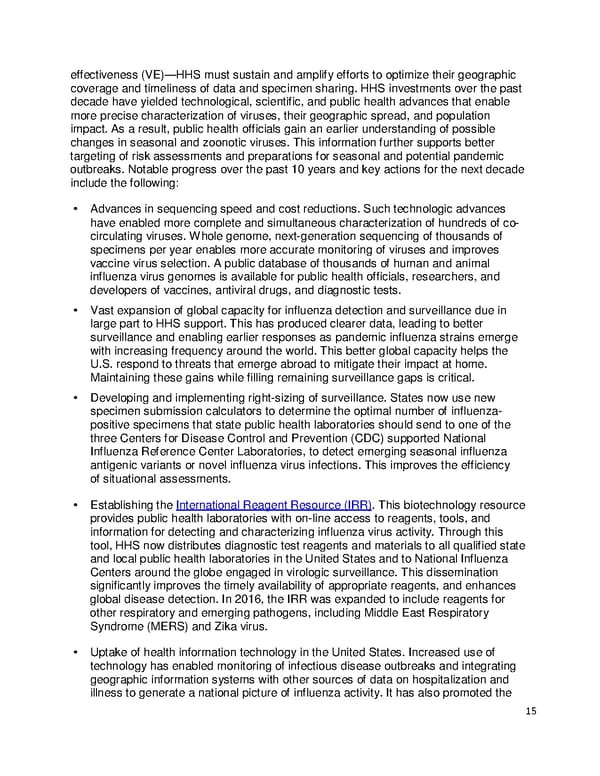effectiveness (VE)—HHS must sustain and amplify efforts to optimize their geographic coverage and timeliness of data and specimen sharing. HHS investments over the past decade have yielded technological, scientific, and public health advances that enable more precise characterization of viruses, their geographic spread, and population impact. As a result, public health officials gain an earlier understanding of possible changes in seasonal and zoonotic viruses. This information further supports better targeting of risk assessments and preparations for seasonal and potential pandemic de outbreaks. Notable progress over the past 10 years and key actions for the next deca include the following: • Advances in sequencing speed and cost reductions. Such technologic advances have enabled more complete and simultaneous characterization of hundreds of co- circulating viruses. Whole genome, next-generation sequencing of thousands of specimens per year enables more accurate monitoring of viruses and improves vaccine virus selection. A public database of thousands of human and animal influenza virus genomes is available for public health officials, researchers, and developers of vaccines, antiviral drugs, and diagnostic tests. • Vast expansion of global capacity for influenza detection and surveillance due in large part to HHS support. This has produced clearer data, leading to better surveillance and enabling earlier responses as pandemic influenza strains emerge with increasing frequency around the world. This better global capacity helps the U.S. respond to threats that emerge abroad to mitigate their impact at home. Maintaining these gains while filling remaining surveillance gaps is critical. • Developing and implementing right-sizing of surveillance. States now use new specimen submission calculators to determine the optimal number of influenza- positive specimens that state public health laboratories should send to one of the three Centers for Disease Control and Prevention (CDC) supported National Influenza Reference Center Laboratories, to detect emerging seasonal influenza antigenic variants or novel influenza virus infections. This improves the efficiency of situational assessments. • Establishing the International Reagent Resource (IRR). This biotechnology resource provides public health laboratories with on-line access to reagents, tools, and information for detecting and characterizing influenza virus activity. Through this tool, HHS now distributes diagnostic test reagents and materials to all qualified state and local public health laboratories in the United States and to National Influenza Centers around the globe engaged in virologic surveillance. This dissemination significantly improves the timely availability of appropriate reagents, and enhances global disease detection. In 2016, the IRR was expanded to include reagents for other respiratory and emerging pathogens, including Middle East Respiratory Syndrome (MERS) and Zika virus. • Uptake of health information technology in the United States. Increased use of technology has enabled monitoring of infectious disease outbreaks and integrating geographic information systems with other sources of data on hospitalization and illness to generate a national picture of influenza activity. It has also promoted the 15
 Pandemic Influenza Plan Page 14 Page 16
Pandemic Influenza Plan Page 14 Page 16